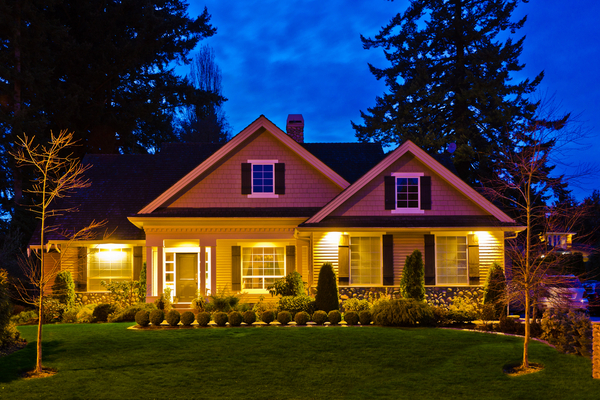The days have gotten shorter and nights longer, and it’s really important to make sure all of your exterior lights are in good working order. Many things can wreak havoc on exterior lighting. Natural elements like weather and vegetation growth are big culprits, but people and animals can be as well. After all, outdoor lighting doesn’t just look pretty, it performs an essential safety function as well.
The good news is that regular outdoor lighting maintenance can help keep your exterior lighting fixtures shining brighter and longer. Here’s a checklist to help light your way:
CLEAN INTERNAL REFLECTORS AND LENSES
The internal reflector is the part of the lamp that surrounds the bulb. This area is there to protect the bulb, but also to help reflect the light out into the desired direction. Wiping off the internal reflectors will help remove any foreign materials allowing them to do their job.
Lenses can become coated by dirt, debris, spider webs, and hard water spots which will block the light emitting from the lamp. Hard water spots can also cause the lens to become dull and cloudy looking. Cleaning the lenses on your fixtures will help restore their brightness.
CLEAN AROUND LIGHT FIXTURES
Over time, fixtures can become blocked or partially covered by grass and other plants, mulch, leaves, dirt, and mud. Even a small amount of blockage can decrease the lumens a light gives off or block the light in certain directions.
Trim or cut back any vegetation blocking illumination of your lights. This can mean plants that are literally growing over your fixtures, or just growing tall enough to block your lighting from reaching the area intended to be lit up.
CHECK FOR COMPROMISED FIXTURES
Check your outdoor lighting fixtures to see if they have been compromised by corrosion, damage, breakage, or dents. Also check whether the wires have become disconnected from the fixture.
Compromised fixtures may have ceased to be water safe. Broken or cracked fixtures can also cut people or animals who knock into them when passing by.
Any fixtures suffering significant damage should be replaced, even if the light continues to work. Sometimes it can be difficult finding the exact same fixture to replace yours with. If so, a lighting professional’s help might be needed if the new light fixture requires more wattage than your old one.
REPLACE BULBS THAT AREN’T WORKING OR ILLUMINATING PROPERLY
During your maintenance check, replace any bulbs that aren’t working. This is a good time to consider upgrading to more energy-efficient bulbs or LED lighting if you haven’t already.
All bulbs can grow tired and start to lose their brightness. Look for areas in your lighting installation that appear dimmer than other areas. Consider replacing these bulbs before they burn out completely, especially if they are lighting up walking pathways, steps or changes in elevation that can cause a hazard.
MAKE SURE FIXTURES ARE PROPERLY POSITIONED
Fixtures can get knocked over or pushed out of alignment. This can occur for many reasons, such as trees limbs falling, being jostled by lawn care equipment, or kids playing in the yard.
So, check for fixtures that have been pushed over or that have moved position due to changes in the ground soil.
Keep the reason the lights were installed in mind when making sure the lights are re-positioned pointing in the right direction. Some lights were designed to be pointing upward, but some are installed to highlight an area.
CHECK FOR EXPOSED WIRES
The wiring running to and between your landscape lighting should be underground. Having the wires buried keeps people, pets, and gardeners from tripping over it or damaging your electrical wire. It also looks tidier.
Provided any exposed wiring you find appears to be undamaged or uncompromised, you can rebury them. However, damaged or compromised wiring needs to be repaired or replaced before it is reburied. This is because wiring that is not sealed properly is not waterproof and can cause serious problems when exposed to water.
USE TIMERS FOR YOUR LIGHTS
You can cut down any unnecessary wear and tear on your exterior lights by having your lights set on a timer or timers. By doing so, you can make sure your lights aren’t on when they aren’t needed.
You can set your lights so they all come on as soon as it begins to get dark, and turn off when it begins to get light. You can also set your timers so only some are on during dawn and dusk, when there is partial sunlight, with the rest of your lights only staying on during full darkness.
—
Photo Credit: karamysh / Shutterstock.com
